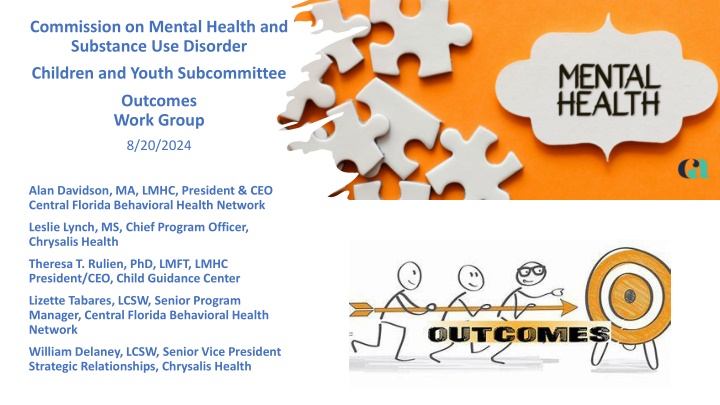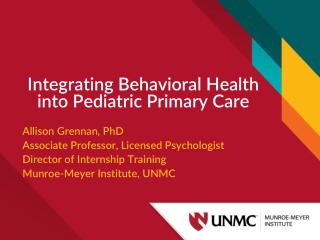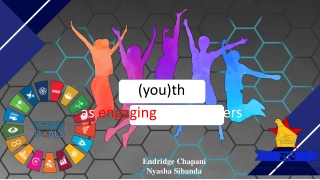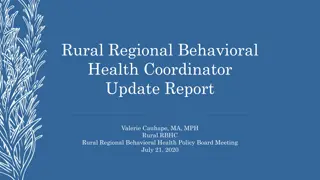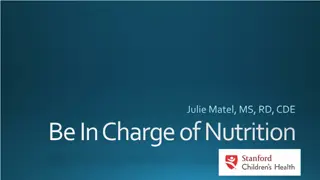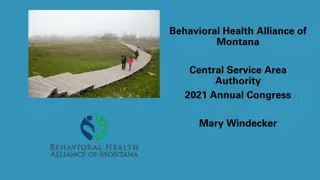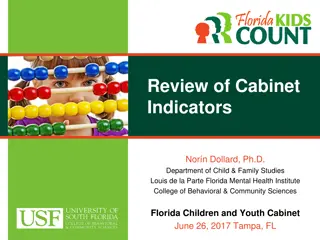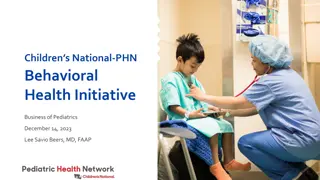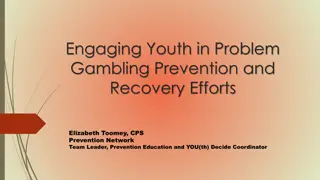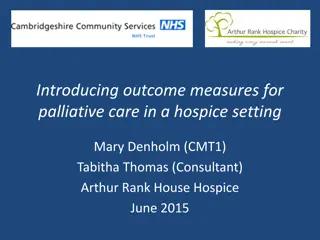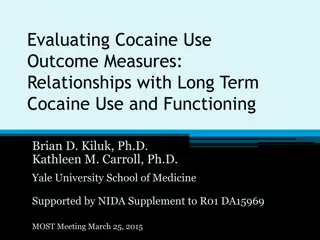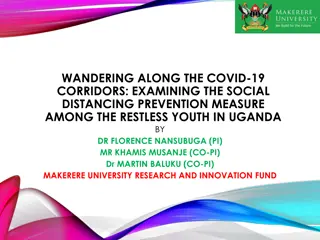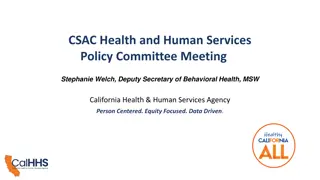Behavioral Health Outcome Measures for Children and Youth
This document outlines the objectives and process of the Outcomes Workgroup tasked with improving and evaluating evidence-based behavioral health outcome measures for children and youth. It includes a review of current measures, data analysis, identification of gaps, recommendation development, and reporting findings. Various tools such as ASAM, CFARS, CALOCUS, and NCFAS are evaluated for their efficacy and applicability in diverse populations and settings.
Download Presentation

Please find below an Image/Link to download the presentation.
The content on the website is provided AS IS for your information and personal use only. It may not be sold, licensed, or shared on other websites without obtaining consent from the author.If you encounter any issues during the download, it is possible that the publisher has removed the file from their server.
You are allowed to download the files provided on this website for personal or commercial use, subject to the condition that they are used lawfully. All files are the property of their respective owners.
The content on the website is provided AS IS for your information and personal use only. It may not be sold, licensed, or shared on other websites without obtaining consent from the author.
E N D
Presentation Transcript
Commission on Mental Health and Substance Use Disorder Children and Youth Subcommittee Outcomes Work Group 8/20/2024 Alan Davidson, MA, LMHC, President & CEO Central Florida Behavioral Health Network Leslie Lynch, MS, Chief Program Officer, Chrysalis Health Theresa T. Rulien, PhD, LMFT, LMHC President/CEO, Child Guidance Center Lizette Tabares, LCSW, Senior Program Manager, Central Florida Behavioral Health Network William Delaney, LCSW, Senior Vice President Strategic Relationships, Chrysalis Health
Improved and evidence- based behavioral health outcome measures that accurately reflect the needs and progress of children and youth, leading to better- informed policy and practice decisions. Outcomes Workgroup Goal:
Outcomes Workgroup Objective and Process PROCESS: 1. Review Existing Measures: Conduct a comprehensive review of currently utilized behavioral health outcome measures for children and youth. Objective Objective: Evaluate and Evaluate and enhance the enhance the effectiveness of effectiveness of behavioral health behavioral health outcome measures outcome measures for children and for children and youth. youth. 2. Data Analysis: Gather and analyze data on the effectiveness and applicability of these measures in diverse populations and settings. 3. Identify Gaps: Identify any gaps or limitations in the current measures, including cultural relevance, age appropriateness, and the ability to capture long-term outcomes. 4. Recommendation Development: Based on the data and analysis, develop informed recommendations for the Subcommittee on the most effective measures to use, considering any necessary modifications or the adoption of new measures. 5. Report Findings: Present the findings and recommendations to the Subcommittee, providing a detailed report that includes data, analysis, and suggested next steps for implementation.
Tools Evaluated Evaluation Metrics Intended Use of the Tool ASAM - American Society of Addiction Medicine Level of Care Assessment Efficacy of the Tool CFARS Children s Functional Assessment Rating Scale Applicability Across Diverse Populations and Settings CALOCUS Child and Adolescent Level of Care Utilization System Total Cost o Cost for tool o Cost for Training/supervision o Cost for fidelity monitoring NCFAS North Carolina Family Assessment Scale CGAS Children s Global Assessment Scale DLA-20 Daily Living Activities 20 Time to Administer GAIN Global Appraisal of Individual Needs Inter-Rater Reliability SAMHSA NOMS SA and MH Services Administration National Outcome Measures Frequency Recommendation BH Works/BHS Behavioral Health Screen Wellness Assessment (Optum) Limitations CANS Child and Adolescent Needs and Strengths Any Data on State-Wide Roll Out CAFAS Child and Adolescent Functional Assessment Scale Any Data on School District/DOE Roll Out
Purpose: Functional assessment tool to measure the impact of mental illness and disability on daily living activities. Developed by the National Council for Behavioral Health and MTM Services. Includes 20 activities covering areas such as grooming, health practices, housing stability, money management, and social networks. Provides a standardized method for clinicians to assess and track functional status and outcomes. History and Development: Created to address the need for a reliable and valid functional assessment tool in behavioral health settings. Designed to capture a 30-day snapshot of a patient's daily living activities. Helps clinicians identify areas of need and measures treatment progress over time. Development driven by the growing demand for outcome-based care. Usage and Implementation: Used by over 500 provider organizations across 43 states. More than 35,000 trained clinicians have served over a million consumers. Implemented state-wide in 14 states. Fully integrated into 37 electronic health records. Training for clinicians is essential to ensure proper use and scoring of the tool. 12 minutes to administer, on average. Daily Activities of Living 20 (DLA-20)
Recommendations Improved and evidence-based behavioral health outcome measures that accurately reflect the needs and progress of children and youth, leading to better-informed policy and practice decisions. The Workgroup recommends the statewide implementation of the DLA-20 Reliable, improved evidence-based functional assessment tool designed to identify areas of need and measure progress over the course of care. Utilized nationally. Fully integrated in 37 electronic health records and able to be integrated in any other for free. Relatively inexpensive (no cost for the tool, EHR integration). State Sponsored Training Program (perhaps the MMA plans), leading to a sustainable Train the Trainer model Recommend increasing the allowable limit of the number of Functional Assessments annually Include the DLA-20 in all new state contracts (DCF, DJJ, DOE) Evaluate the DLA-20 for continued relevance every 2 years Evaluate the marketplace for new or emerging tools every 2 years
The Agency for Health Care Administration Partners to Mobilize Recommendations Medicaid Managed Care Plans The Department of Education The Department of Children and Families Managing Entities Community Based Care Entities The Department of Juvenile Justice The Florida Behavioral Health Association MTM Consulting
Move towards value-based care with measurable outcomes driving policy and funding decisions Improved outcome measurement for clinicians, guiding effective treatment interventions Change management in terms of statewide roll out of the tool Impact of Recommendations Training requirement ensuring accurate use of the tool Funding to cover initial training for roll out Increased Medicaid limit for administration as needed
